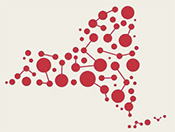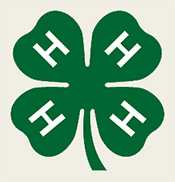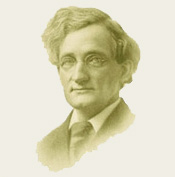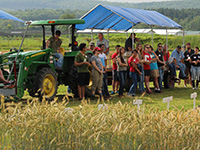Adapt these activities to the age, interest, and skill levels of your group.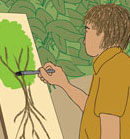
Leaf Print Casting (pdf)
Painted Leaf Prints(pdf)
Chlorophyll Prints(pdf)
Connections to NYS Learning Standards
Capturing the beauty and unique aesthetic qualities of plants in your garden can be easily done through the creative art of printmaking. Printmaking works well in any season, since each time of year offers a new variety of patterns and forms in the plant world to print. Also, experimenting with different printmaking techniques and styles will allow you to create infinite images with a single leaf.
A Little Printmaking History
- Can you remember the first print you ever made? As newborn babies, we all made our first print in this world when our tiny feet were stamped at the hospital.
- Printmaking is a universal practice that is as common today as it was in ancient times. It is not only an art form but a scientific tool for learning about and recording plants. From the 13th-19th centuries, botanists, herbalists, and doctors used herbal prints for medical research and identification.
- The first medical text was called the “Herbals” and it contained prints of the different plants used by doctors, pharmacists and herbalists. Printmaking was regarded as the most accurate form of documenting plants, since many botanists didn’t have the artistic training needed to draw them accurately. The Herbals included medicinal recipes and related prints. But plant prints weren’t the only prints included. One Italian herbalist described a formula for long life and included a print of a viper snake, which was an ingredient in that recipe.
- Benjamin Franklin was a printmaker by trade, and in 1739 he began printing a leaf on the back of paper currency, in order to deter counterfeiting. His theory behind the leaf printing was that the veins on the leaves were too intricate to be duplicated by anything hand carved. While his method proved to be successful, he developed a secret way to mass-produce a single leaf print from one casting. Even to this day, his method remains a secret.
- With the development of color photography by the late 1800s, printmaking was abandoned by much of the scientific community. However, it has remained an art form used by artists. The variety of techniques and mediums for printmaking developed over time has left today’s print maker with a vast selection of methods to choose from.
Did you know…
Tapa cloth is a cultural art from the South Pacific that uses printmaking to decorate cloth that was traditionally made from the paper mulberry tree. To produce the cloth the moist, soft inner bark of the tree is beaten until it expands into thinner, wider sheets, which are then decorated using various natural dyes and pigments such as turmeric, leaves, sap, blood, soot, clay, and soil. Printmaking patterns are then made by carving pieces of wood, which are inked and stamped onto the cloth to produce designs. The art of decorating the tapa cloth with prints was very important—balance and symmetry were important aspects of the designs, which often included natural elements such as plants, fish, and shells. The amount of cloth and the style in which it was decorated with prints, designated social factors such as status, wealth, and social rank.
Printmaking Project Ideas
- Create your own herbal registry: Learn about the medicinal properties of some plants growing in your garden, make prints with them, and then document your prints with their herbal recipes.
- Make a printed garden harvest calendar: Make prints of your garden harvest so the following year you’ll have a beautiful garden harvest calendar to refer to.
- Printing with nature’s own pigments: Use a hammer to pound your plant prints and discover the natural printing properties of chlorophyll.
- Make a garden journal: Start with printing the seeds you are going to plant in your garden and as the plants grow, document their development with prints and descriptions. When the plants are at full maturity, select those best for printing and add their prints to your garden journal. At the end of the season, you’ll have a fully documented garden journal with your plants’ growth from seed to harvest illustrated in beautiful prints and drawings.
Printmaking Techniques
The printmaking technique that will be used in printing garden leaves and materials is called relief printing. In this printing method, the ink goes on the raised surface of the printing material.
Basic Printmaking Materials
- Inks: There are oil-based and water-based inks. Oil-based inks need to be mixed with linseed oil, poppy seed oil, or any other oil used for printmaking. This reduces the stickiness and helps make sure that the object prints evenly. Water-based inks tend to dry too quickly on the palette, to be useful. But Graphic Chemical and Ink Company (www.graphicchemical.com) sell water-based inks that don’t dry up and won’t wash off.
- Palettes
- Pigment applicators: Brayers, brushes, dabbers
- Printing materials: Leaves, bark, pine cones, shells, and other natural objects found in or around the garden.
Procuring Natural Materials to Print
The garden is the best place to find a large variety of leaves, flowers, fruits, vegetables, small nuts, and even spider webs that can be printed. Be sure to collect things on a dry day and be sure the dew has evaporated from the plants. Leaves are much easier than flowers for beginners at printmaking or for younger audiences. As you collect plants for printing, place them in small plastic bags. In your garden journal, keep track of where you collected the plants, what were around them, etc. List the names of plants collected. Bring along a field guide if there are certain plants in the garden that you don’t recognize.
Your prints will depend on how you press your plants. The easiest way to press them is with an old heavy phone book. Pressing them for an hour is enough time to make them flat and ready for printing.
Flowers are difficult to press, because they won’t make an accurate print if not pressed first, but once pressed they often fall apart. The best option is to press for only a few minutes. For larger plants and flowers, remove the parts, press separately and join together again in the final printing stage.
Fruits and vegetables are best used fresh and cut in half to expose inner seeds and structures. Make sure to blot them well to rid excess moisture before paint is applied.
Did you know that leaves can be stored in a freezer for up to a year? They can be stored in plastic freezer bags and when taken out, will defrost quickly and will be ready for printing use. This is one way to extend your printing activities into the winter months.
top
Connections to NYS Learning Standards
Activity: LEAF PRINT CASTING
Health, Physical Education, and Home Economics
STANDARD 2 Students acquire knowledge/ability necessary to maintain a healthy environment. Students develop community approaches which enhance and protect the quality of the environment. Students create art for the garden like a bird bath, birdseed feeder, or path ornament.
STANDARD 3 Students understand and manage personal and community resources. Students preserve beauty of garden harvest.
Mathematics, Science, and Technology
STANDARD 1 Students use mathematical analysis, scientific inquiry, and engineering design to pose questions and develop solutions.
STANDARD 2 Students access, generate, process, and transfer information using technologies.
STANDARD 4 Students understand and apply scientific concepts, principles and theories as they capture in concrete unique patterns and forms in the garden.
STANDARD 5 Students apply technological knowledge and skills to design, construct, use, and evaluate products. Students as a group plan and implement a school project.
STANDARD 6 Students understand and apply relationships and common themes that connect math, science, and technology. Use simple instruments.
STANDARD 7 Students apply knowledge and skills of math, science, and technology to address problems. Evident when students improve their environment.
English Language Arts
STANDARD 1 Students listen, speak, read, and write for information and understanding. Students collect data, facts, and ideas, discovering relationships, concepts, and generalizations, and using knowledge from oral, written, and electronic sources. Students access online reference materials.
The Arts
STANDARD 2 Students make use of materials and resources for participation in the arts. Students can experiment with other art mediums besides concrete — clay, crayon rubbings, photography, and drawing what you see through a magnifying lens.
Students make their own ink and print designs.
STANDARD 3 Students will analyze visual characteristics of the natural environment and explain social, cultural, psychological, and environmental dimensions of the visual arts. Students respond critically to variety of works in the arts.
STANDARD 4 Students understand personal and cultural forces that shape artistic communications. Students explore concept of art made with nature.
Activity: PAINTED LEAF PRINTS
Health, Physical Education, and Home Economics
STANDARD 3 Students understand and manage personal and community resources. Students gather objects found in the garden like leaves, twigs, mosses, rocks, etc.
Mathematics, Science, and Technology
STANDARD 1 Students use mathematical analysis, scientific inquiry, and engineering design to pose questions and develop solutions.
STANDARD 2 Students access, generate, process, and transfer information using technologies.
STANDARD 4 Students understand and apply scientific concepts, principles and theories.
STANDARD 5 Students apply technological knowledge and skills to design, construct, use, and evaluate products. Students as a group plan and implement a school project.
STANDARD 6 Students understand and apply relationships and common themes that connect math, science, and technology. Students use simple instruments.
English Language Arts
STANDARD 1 Students listen, speak, read, and write for information and understanding. Students collect data, facts, and ideas, discovering relationships, concepts, and generalizations, and using knowledge from oral, written, and electronic sources. Students access online resources.
The Arts
STANDARD 2 Students make use of materials and resources for participation in the arts. Students experiment and create art works in a variety of mediums. Students can use painted prints of leaves and flowers along with fruits and vegetables.
STANDARD 3 Students will analyze visual characteristics of the natural environment and explain social, cultural, psychological, and environmental dimensions of the visual arts. Students respond critically to variety of works in the arts.
STANDARD 4 Students understand personal and cultural forces that shape artistic communications. Students explore concept of art made with nature.
Activity: CHLOROPHYLL PRINTS
Health, Physical Education and Home Economics
STANDARD 3 Students understand the kinds of resources available in their community and make informed decisions related to their own use. Students work with green leaf vegetables like kale & spinach, herbs like basil and mint and leaves from trees and shrubs.
Mathematics, Science, and Technology
STANDARD 4 Students understand and apply scientific concepts, principles and theories. Students learn about chlorophyll, the green pigment in plants, and the process of photosynthesis.
STANDARD 5 Students apply technological knowledge and skills to design, construct, use, and evaluate products. Students as a group plan and implement a school project.
STANDARD 6 Students understand and apply relationships and common themes that connect math, science, and technology. Use simple instruments.
STANDARD 7 Students apply knowledge and skills of math, science, and technology to address problems. Evident when students improve their environment.
English Language Arts
STANDARD 1 Students listen, speak, read, and write for information and understanding. Students collect data, facts, and ideas, discovering relationships, concepts, and generalizations, and using knowledge from oral, written, and electronic sources. Students access online resources.
The Arts
STANDARD 2 Students experiment and create art works in a variety of mediums. Students can try different leaves and paper or fabric materials to make journals, class books, or flags.
STANDARD 3 Students will analyze visual characteristics of the natural environment and explain social, cultural, psychological, and environmental dimensions of the visual arts. Students respond critically to variety of works in the arts. Evident when students look at photographs of Vietnamese artist Binh Danh.
STANDARD 4 Students understand personal and cultural forces that shape artistic communications. Students explore concept of art made with nature.
top

